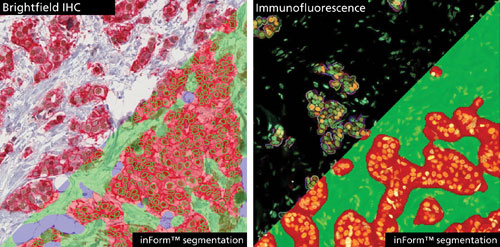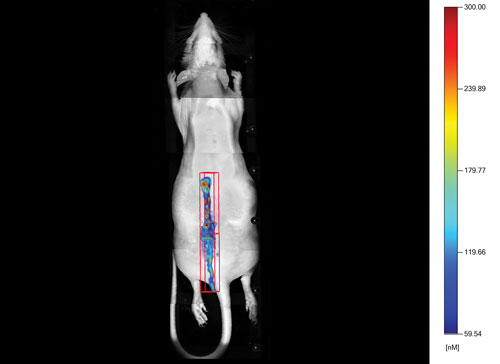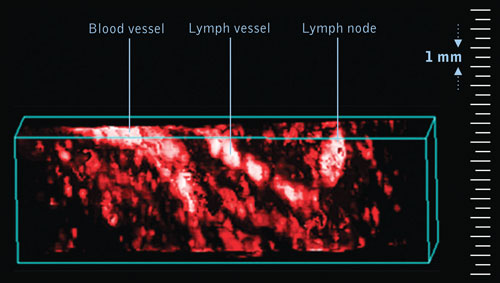May 1, 2011 (Vol. 31, No. 9)
Vicki Glaser Writer GEN
Increased Speed, Automation, and Visualization Should Bring Field to Another Level
A range of new technologies and products made their debut at the AACR annual meeting in April, each designed to make cancer research faster, easier, and more biologically and clinically relevant. With an emphasis on automation, genetic and epigenetic analysis, and in vivo cell, tissue, and live-animal imaging, the new technologies on display target key bottlenecks in the drug discovery pipeline.
Compact and easy to use, the new Moxi Z mini automated cell counter from Orflo combines the Coulter Principle (change in impedance) with a thin-film sensor technology to perform particle sizing (range 2–34 microns) and counting and viability reporting of a 75 µL sample in 8 seconds, for a cost of about $1.50/test.
Later this month, Sigma-Aldrich plans to introduce a genetically modified breast cancer model cell line as part of its family of oncology cell lines developed with the CompoZr® Zinc Finger Nuclease (ZFN) technology. The first oncology products introduced were colorectal and lung cancer models. The technology allows for the introduction of targeted, heritable changes to create either knock-out disease models or knock-in models in which a specific mutation is created in a gene that remains under the control of its endogenous promoter.
In the third quarter, Randox expects to launch the QuantiPlasma Array system for biomarker discovery. Designed for analyzing proteome dynamics in plasma samples from normal and disease populations, QuantiPlasma Array kits each contain 300 monoclonal antibodies spotted across 18 biochips. The Biochip Array Technology allows for simultaneous testing of all 300 antibodies in less than 3 hours using as little as 5 µL of sample, the firm reported.
A poster presented at AACR by NanoInk described the development of a nano-scale sandwich ELISA assay platform using the company’s dip-pen nanolithography (DPN™) technology. These protein nanoarray assays can reportedly achieve sensitivity in the hundreds of femtograms per milliliter range and detect biomarkers in as little as 2–4 µL of sample.
Olink Bioscience launched the Proseek® homogeneous, real-time PCR-based assay, capable of protein quantification in a 1 µL plasma or serum sample.
Cerulean Pharma outlined plans for a Phase II clinical trial in 140 patients with non-small-cell lung cancer (NSCLC) of its tumor-targeted nanopharmaceutical CRLX101, composed of camptothecin-containing nanoparticles.
At AACR, Cerulean and its collaborators presented data from an ongoing 36-patient Phase IIa expansion study of CRLX101 to evaluate the biological activity and tolerability of the drug in patients with solid tumors who had failed standard therapy. Multiple patients with advanced NSCLC who have been treated with the drug during the Phase IIa trial have had stable disease for longer than six months. The size and surface properties of the nanoparticle carrier target the drug to the tumor, where the complex takes advantage of the leaky neovasculature to penetrate the tumor, where the drug is released from the nanoparticles, which break down and are excreted from the body.
Real-Time Imaging
VisualSonics (a subsidiary of Sonosite), launched the Vevo LAXR photoacoustic imaging system designed for preclinical in vivo imaging. It combines high frequency ultrasound and laser-based optical imaging. The ability to perform multispectral imaging allows for visualization of the tumor microenvironment and vasculature and supports detection of lymph nodes and metastatic disease, monitoring of therapeutic response, nanoparticle research, oxygen saturation quantification, and assessment of angiogenesis.

Sentinel lymph node detection using photoacoustic imaging: 3-D image of mouse axillia showing the lymph node and associated lymph vessels, imaged using contrast dye—methylene blue at 680 nm. [VisualSonics]
With the acquisition of Cambridge Research & Instrumentation (CRi), Caliper Life Sciences added new multiplexed in vivo and tissue imaging technology to its existing family of Quantum FX µCT and IVIS® preclinical imaging systems. The newly acquired instruments include CRi’s Nuance™ and TRIO™ for multispectral imaging on brightfield and fluorescence microscopes, Vectra™ for high-throughput slide imaging, and Maestro™ for in vivo optical imaging.

Multispectral brightfield and fluorescence imaging (upper-left images) can be used to more effectively separate stains and probes in the same tissue section and improve tissue and cell segmentation (lower-right images). Since there is no need to utilize serial sections, one can gain a better understanding of the specimen. [Caliper Life Sciences]
PerkinElmer introduced a Multispecies Imaging Module (MSIM) for its Fluorescence Molecular Tomography (FMT) in vivo imaging systems, which can be used to generate quantitative 3-D datasets from small and large animal models. The company has upgraded its TrueQuant™ analysis software for the new module. The FMT 2500 LX in vivo imaging system can perform multiplexed analysis using up to four different fluorophores, according to company literature.
The iBox Explorer fluorescence imaging microscope, new from UVP , allows for imaging of whole organs down to the cellular level using a CCD camera and optics that span the visible to near-infrared spectrums and a range of BioLite™ filters. The imager captures signals from green fluorescent protein and red fluorescent protein.
At AACR, CompuCyte featured its iCys cytometric software for performing live-cell analysis on its iGeneration laser-scanning cytometers. The company is developing a live-cell analysis chamber that will enable repetitive scanning studies.

PerkinElmer’s Multispecies Imaging Module (MSIM) enables researchers to generate 3-D datasets of animal models relevant to disease research, including imaging capability for larger animals.
A poster presented by researchers from University of Michigan described the use of Promega’s GloSensor™ luciferase biosensor technology to develop a bioluminescent imaging assay designed to detect caspase-dependent cell death in living mice as a surrogate marker to assess the efficacy of cancer therapeutics.
With GloSensor constructs, increasing amounts of caspase-3/7 in a cell that stably expresses genetically modified luciferase results in a conformational change in the molecule that allows a signal to be generated. The poster describes the use of a bioluminescent reporter to image apoptosis in cancer cell lines and mouse models in a high-throughput screening format.

Demonstration of an optimized bioluminescent biosensor (from Promega) for the detection of cell death in living animals: Representative images taken at indicated time points of intratibial implanted 1833 reporter cells. TRAIL treatment (8 mg/kg) resulted in a 100–200 fold induction of bioluminescence activity that correlated with cell death as demonstrated by increased cleavage of caspase-3. The high signal to noise and dynamic range of reporter activity provides a sensitive and quantitative surrogate for the evaluation of experimental therapeutics.
Genetic Analysis
Expression Analysis will be adding Pacific Biosciences’ PacBio S third-generation long-read DNA sequencing platform to its genetic analysis capabilities. Expression Analysis initially plans to use the PacBio RS for viral sequencing, with a focus on hepatitis C virus, followed by HLA typing applications.
PacBio is using Agilent Technologies’ SureSelectXT target-enrichment technology to perform targeted sequencing of the kinome and to analyze full-length transcripts of cancer-related genes. Agilent’s SureSelect system also supports next-gen sequencing technology from Illumina Applied Biosystems and Roche, and a kit compatible with the Ion Torrent Personal Genome Machine is in development.
The system includes the Human Kinome Kit, which covers 3.2 megabases and 612 genes including more than 500 known kinases, as well as exome target-enrichment kits for human, mouse, and other model organisms. Agilent recently announced an expansion of its SureSelect custom kits (which previously had a range of <200 Kb to >6.8 Mb) and are now capable of up to 34 Mb. At AACR, Agilent also highlighted the combined gradient functionality and uniformity attributes of its new SureCycler 8800 thermal cycler.
Affymetrix introduced its OncoScan™ FFPE Express 2.0 service, which provides copy number, allelic ratio, and somatic mutation data from FFPE tissue samples. The company held a workshop in which it presented its Molecular Inversion Probe (MIP) technology for selective amplification of a locus of interest in an FFPE sample. The workshop also focused on the company’s QuantiGene® ViewRNA in situ expression assays for whole-transcriptome analysis to support pathway analysis.
Life Technologies introduced its TaqMan® Mutation Detection Assays, based on Competitive Allele-Specific TaqMan polymerase chain reaction (castPCR), a technology that combines amplification of gene regions containing targeted mutations and suppression factors capable of silencing other DNA molecules present in the sample. The newly launched Mutation Detection Assays are part of an early-release program focusing on mutation detection in three human genes—KRAS, BRAF, and EGFR—associated with colorectal, lung, pancreatic, and breast cancer.
New from RainDance Technologies is the HLASeq™ Research Screening Panel for next-gen sequencing of the human leukocyte antigen (HLA) and major histocompatibility complex (MHC) genes. The assay allows researchers to search the entire 3.8-megabase HLA super locus at single-base resolution to identify polymorphisms.
Stratedigm showcased the S1000Ex 14-color upgrade kit for its S1000 flow cytometers, which are designed to support up to four lasers with spatial separation and include a range of user-interchangeable optical filters, enabling fluorescence detection of up to 14 fluorophores.
Epigenetics
Epigentek introduced the EpiQuik™ hydroxymethylated DNA Immunoprecipitation (hMeDIP) Kit for the selective enrichment of 5-hydroxymethylcytosine (5-hmC)-modified DNA fragments in a 96-well plate format. The company also featured its MethylFlash™ Hydroxymethylated DNA Quantification Kit for colorimetric quantification of 5-hmC at genome-wide scale without cross-reactivity to methycytosine or unmethylated cytosine.
The AACR meeting marked the launch of New England Biolabs’ EpiMark™ Methylated DNA Enrichment Kit and EpiMark Bisulfite Conversion Kit. The Methylation DNA Enrichment Kit facilitates enrichment of CpG methylated DNA in less than two hours, using human methyl binding domain (MBD2) bound to the Fc tail of the human antibody IgG1 as the capture agent. When further coupled to protein A-coated magnetic beads, this antibody-like protein enables methylated DNA purification with enhanced sensitivity and accuracy.
The kit is the result of a research collaboration between New England Biolabs and Sequenom; the companies recently announced a licensing and co-marketing agreement to produce research tools for epigenetics.
To study the role DNA methylation plays in regulating gene expression and contributing to the development of diseases such as cancer, Illumina offers the Infinium Methylation Assays, which are capable of quantitative analysis of methylation sites at single nucleotide resolution in 12 samples run in parallel.
Illumina’s HumanMethylation27 BeadChip interrogates 27,578 cytosine methylation (CpG) loci; the HumanMethylation450 BeadChip provides coverage of more than 450,000 methylation sites and is designed for high-throughput screening in genome-wide association studies. Illumina presented two posters that focused on the capabilities of the Infinium methylation assays and their use with restored DNA derived from FFPE samples.
Diagenode spotlighted its automated epigenetics platform, including the SX-8G IP-Star® and SX-8G Compact systems and kits for performing automated chromatin immunoprecipitation and DNA methylation assays.



